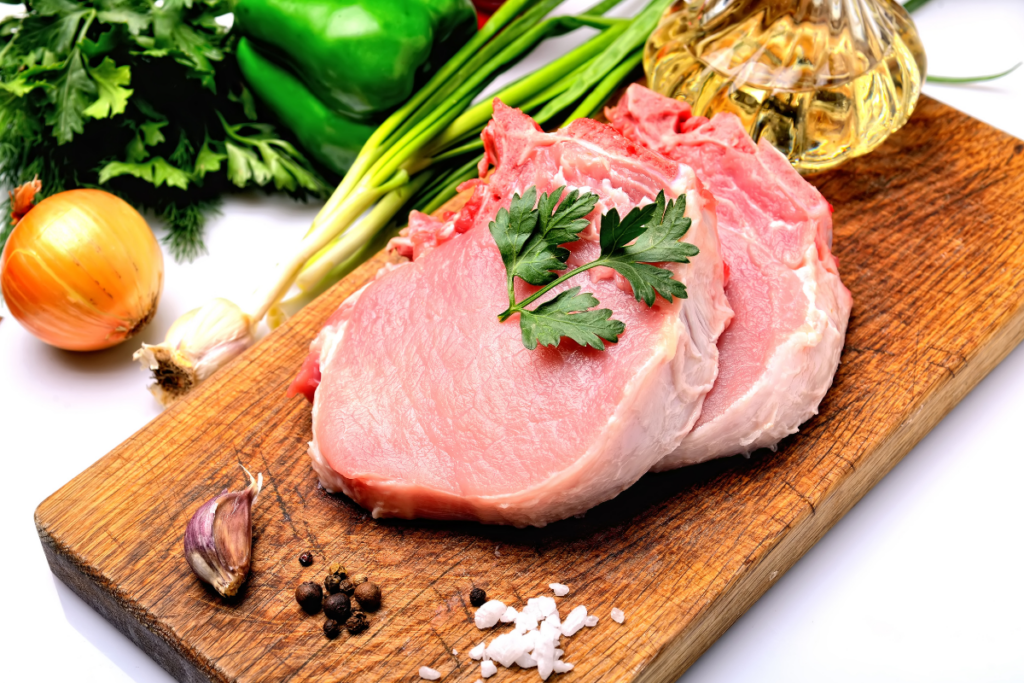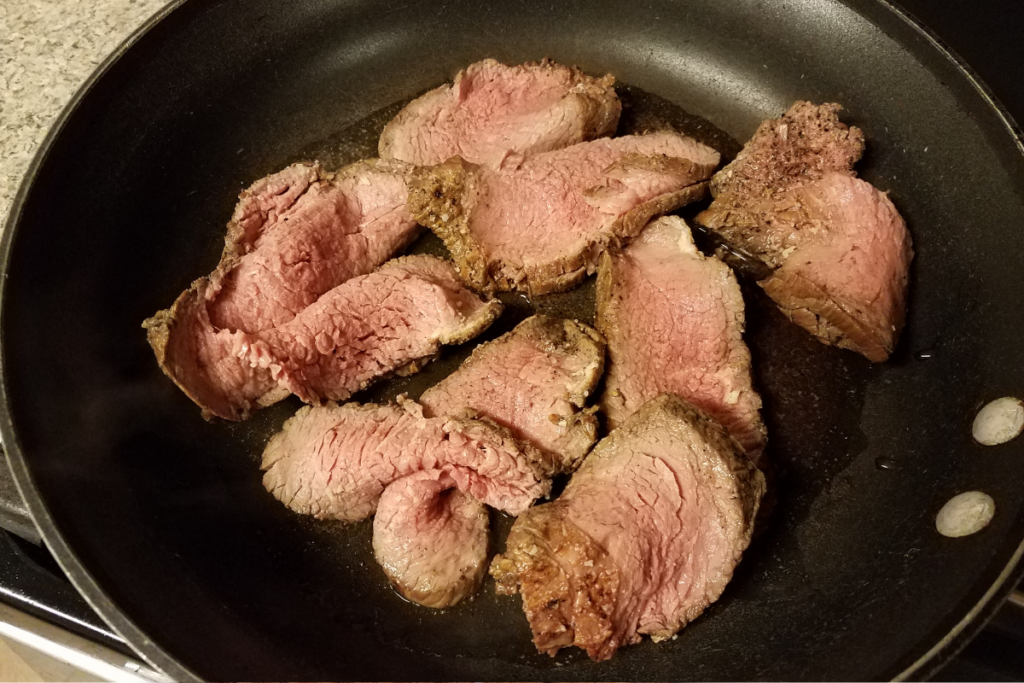If you’ve ever cooked pork, you’ve probably wondered whether it’s okay if pork is a little pink in the middle.
After all, we’ve been taught to cook pork until it’s white all the way through to avoid the risk of food poisoning.
However, recent changes in USDA guidelines suggest that a little bit of pink in cooked pork is actually safe to eat.
While many people still believe that pink pork is undercooked and therefore dangerous, the truth is that the color of pork can vary depending on a number of factors.
In fact, some cuts of pork can be pink even when they’re fully cooked.
So how do you know when it’s safe to eat pork that’s a little pink?
And why has the USDA changed its guidelines on cooking pork?
In this article, we’ll explore these questions and more to help you understand whether it’s okay to eat pink pork.

Is It Okay If Pork Is a Little Pink?
If you are someone who loves to cook pork, you might have been told that pork should be cooked until it is completely white.
But is that really true?
Can pork be a little pink and still be safe to eat?
Let’s explore this topic in more detail.
USDA Guidelines on Pork
According to the United States Department of Agriculture (USDA), the safe minimum internal temperature for pork is 145°F (63°C).
At this temperature, the pork may still be slightly pink, but it is safe to eat.
The USDA recommends using a food thermometer to ensure that pork has reached this temperature before consuming it.
It is important to note that this temperature applies to whole cuts of pork, such as pork chops and roasts.
Ground pork and sausage, on the other hand, should be cooked to an internal temperature of 160°F (71°C) to ensure that any harmful bacteria are destroyed.
Scientific Studies on Pink Pork
Several scientific studies have also shown that pink pork can be safe to eat.
The pink color in cooked pork is often due to a chemical reaction between the proteins and amino acids in the meat.
This reaction can occur even when the pork has been cooked to a safe temperature.
One study published in the Journal of Food Protection found that cooking pork to an internal temperature of 145°F (63°C) was sufficient to kill all bacteria and parasites while still leaving the pork pink, juicy, and tasty.
Another study published in the Journal of Muscle Foods found that pork cooked to an internal temperature of 140°F (60°C) was safe to eat, as long as it was held at that temperature for at least 35 minutes.
In conclusion, pork can be a little pink and still be safe to eat as long as it has been cooked to the recommended internal temperature of 145°F (63°C).
However, ground pork and sausage should be cooked to a higher temperature of 160°F (71°C) to ensure that any harmful bacteria are destroyed.
Always use a food thermometer to check the internal temperature of your pork to ensure that it is safe to eat.
Potential Health Risks
When it comes to cooking pork, many people wonder if it’s okay for the meat to be a little pink.
While some cuts of pork can be eaten with some pink, others, like ground pork and sausage, need to be cooked longer to be safe to eat.
Here are some potential health risks to consider when consuming pink pork.
Foodborne Illnesses
Consuming undercooked pork can lead to foodborne illnesses, which can cause symptoms like nausea, vomiting, stomach cramps, and diarrhea.

These symptoms can range from mild to severe, depending on the type of bacteria or virus that’s causing the illness.
Common foodborne illnesses associated with undercooked pork include E. coli, Salmonella, and Listeria.
To avoid foodborne illnesses, it’s important to cook pork to the proper temperature.
The USDA recommends cooking pork to an internal temperature of 145°F, followed by a three-minute rest time.
This will help ensure that any harmful bacteria or viruses are killed off and the meat is safe to eat.
Parasitic Infections
Another potential health risk associated with consuming undercooked pork is parasitic infections.
In the past, people were afraid of pink pork because of a parasite known as trichinosis, but the risk of contracting it is virtually nonexistent these days.
However, there are still other parasites that can be found in undercooked pork, such as Toxoplasma gondii and Taenia solium.
To avoid parasitic infections, it’s important to cook pork to the proper temperature and avoid consuming raw or undercooked pork.
It’s also important to practice good food safety habits, such as washing your hands and kitchen surfaces frequently and avoiding cross-contamination between raw meats and other foods.
In conclusion, while it’s okay for pork to be a little pink, it’s important to cook it to the proper temperature to avoid foodborne illnesses and parasitic infections.
By following proper cooking techniques and food safety practices, you can enjoy delicious and safe pork dishes.
Cooking Pork Safely
When it comes to cooking pork, safety is key.
Pork can be a delicious and nutritious addition to your diet, but it’s important to make sure it’s cooked properly to avoid any potential health risks.
Here are some tips for cooking pork safely:
Proper Cooking Temperature
The USDA recommends cooking pork to an internal temperature of 145°F (63°C) followed by a three-minute rest time.
This temperature ensures that harmful bacteria, such as Salmonella and E. coli, are destroyed.
Pork that is cooked to this temperature may still have a slight pink color in the center, which is perfectly fine.
If you’re cooking ground pork, such as in meatballs or burgers, the internal temperature should be 160°F (71°C).
This is because ground pork has a higher risk of contamination due to the increased surface area.
Use of Food Thermometer
The best way to ensure that your pork is cooked to the proper temperature is by using a food thermometer.
Insert the thermometer into the thickest part of the meat, making sure not to touch any bone or fat.
Wait for the temperature to stabilize before reading it.
It’s important to note that color is not a reliable indicator of doneness for pork.
Even if the pork looks fully cooked, it may not have reached the proper internal temperature.
Using a food thermometer is the only way to be sure that your pork is safe to eat.
By following these tips, you can enjoy delicious and safe pork dishes.
Remember to always cook pork to the proper temperature and use a food thermometer to ensure that it’s fully cooked.

Key Takeaways
If you’re wondering whether it’s safe to eat pork that’s a little pink in the middle, the answer is yes!
Here are a few key takeaways to keep in mind:
- Trichinosis, a parasite that used to be a concern with undercooked pork, is virtually nonexistent in pork today.
- The current USDA guidelines recommend cooking pork to an internal temperature of 145°F (63°C), which will give you a little bit of pink in the middle.
- Chemical reactions between amino acids in the proteins in meat can also cause pork to be pink, even if it’s fully cooked.
- Investing in a meat thermometer can help ensure that your pork is cooked to the appropriate temperature.
Overall, as long as you cook your pork to the recommended temperature and use a meat thermometer to check, there’s no need to worry about a little bit of pink in the middle.
Enjoy your pork chops, tenderloin, and other cuts without fear!
